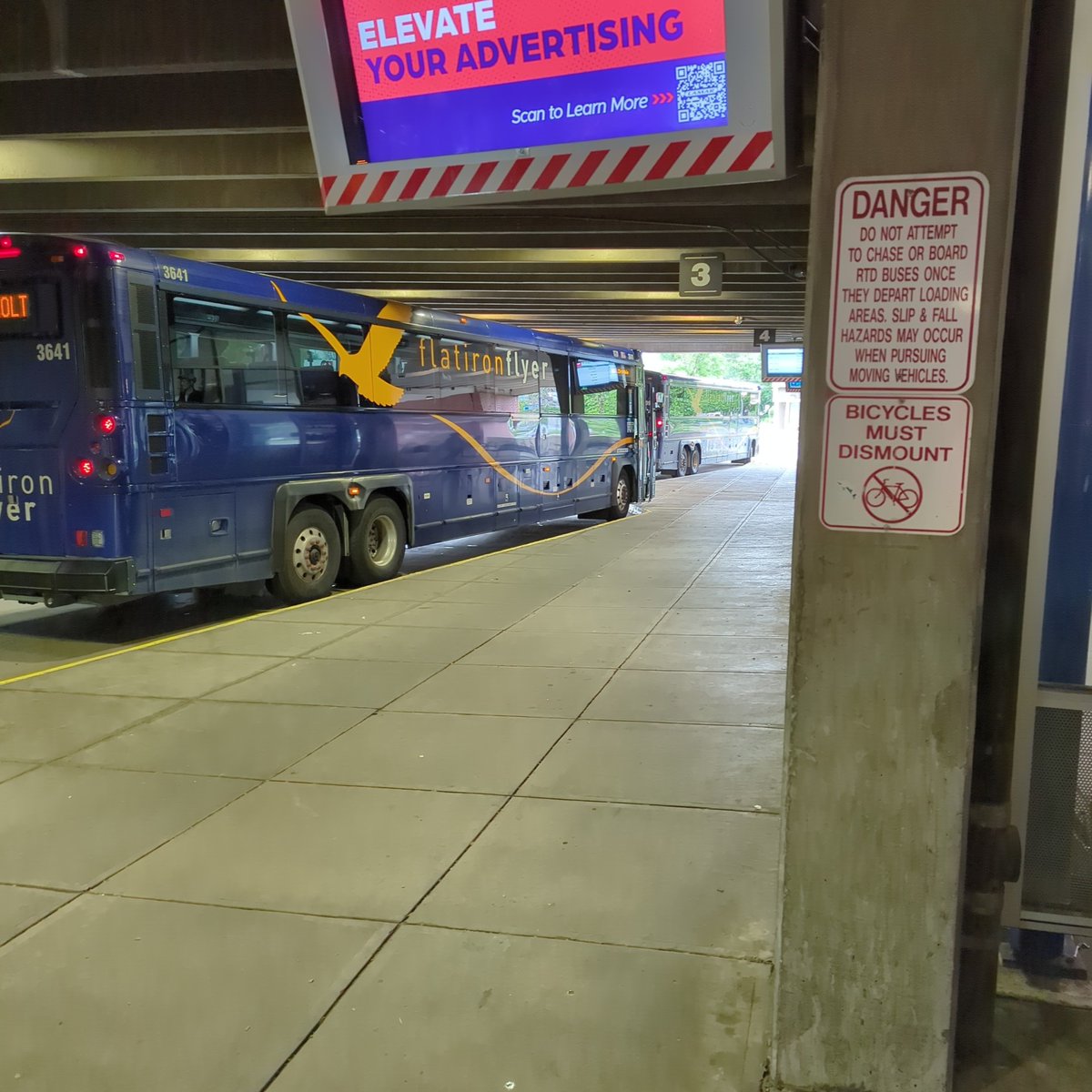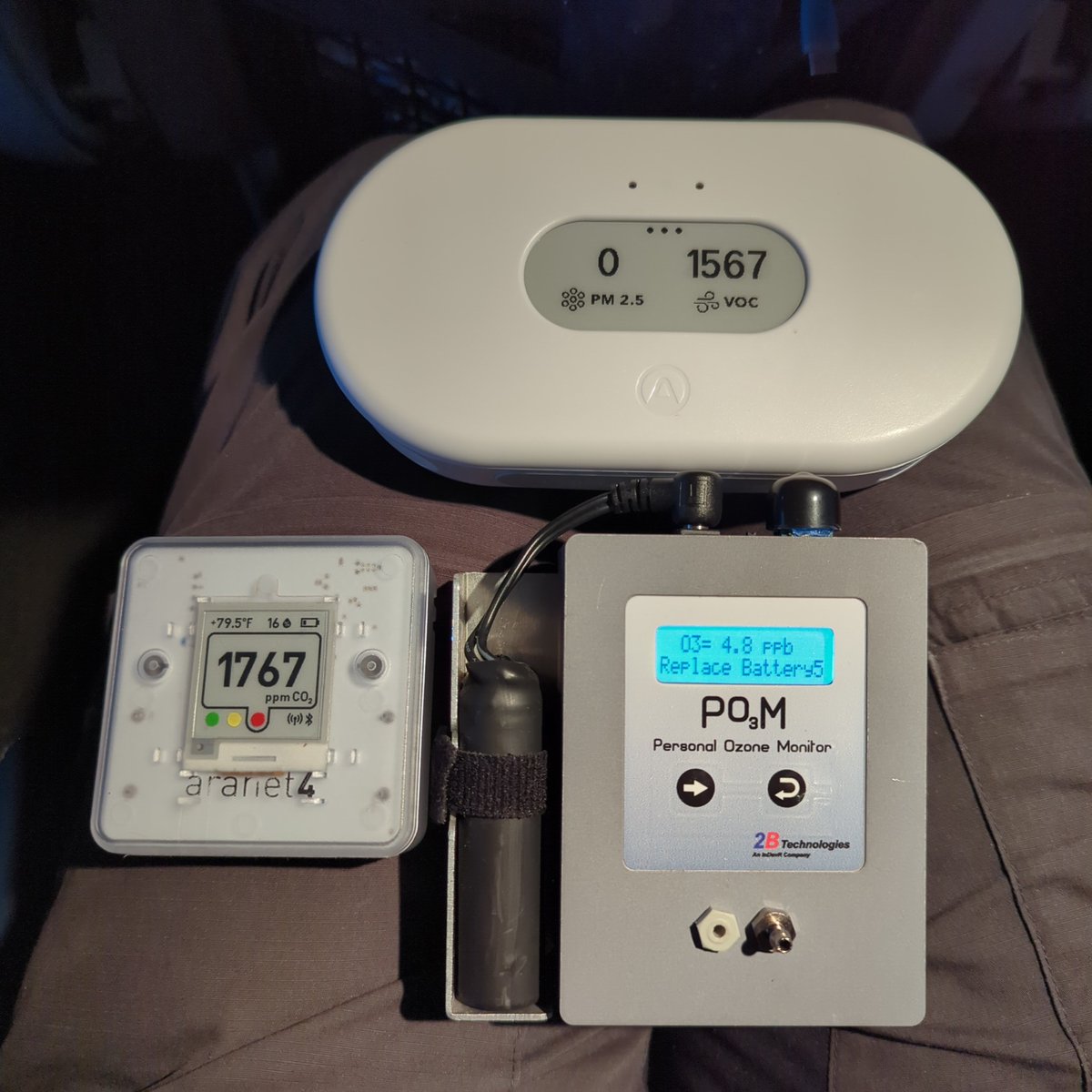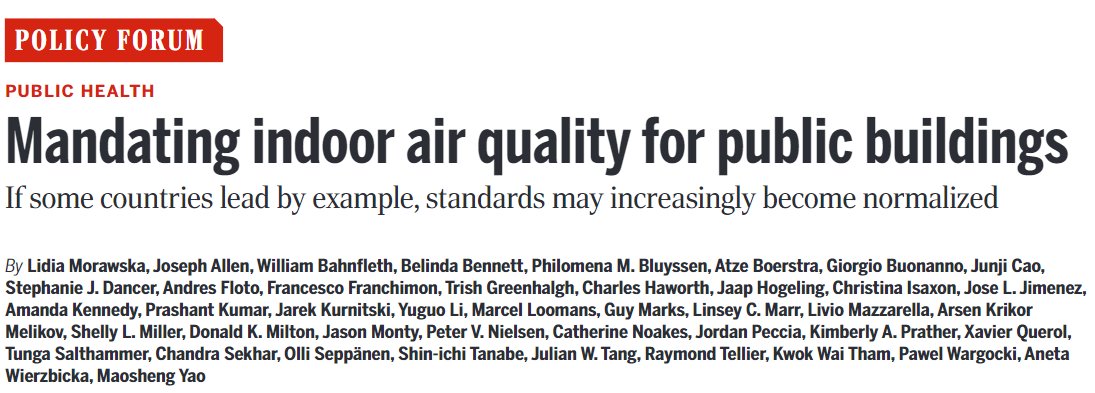1/ Travelling from Colorado to New York City for #ICFUST conference with low-cost air quality sensors.
New: @2b_technologies POM portable ozone monitor.
Semi-outdoors waiting for the bus:
-CO2: 588 (some exhaust)
-PM: 0 (rained yesterday *)
-VOC: 65 (low)
-O3: 15 ppb (**)
New: @2b_technologies POM portable ozone monitor.
Semi-outdoors waiting for the bus:
-CO2: 588 (some exhaust)
-PM: 0 (rained yesterday *)
-VOC: 65 (low)
-O3: 15 ppb (**)

2/ Some expl:
@RideRTD Boulder bus station, like a tunnel open on both sides. Modern diesel buses running
- some CO2 from diesels
- Ultrafine PM, low-cost sensors can't see (too small for their lasers)
- Diesels emits very low VOC
- Emit NO, which destroys O3
All checks
@RideRTD Boulder bus station, like a tunnel open on both sides. Modern diesel buses running
- some CO2 from diesels
- Ultrafine PM, low-cost sensors can't see (too small for their lasers)
- Diesels emits very low VOC
- Emit NO, which destroys O3
All checks

3/ @RideRTD airport bus, at the start of 1:15 h trip
- CO2: 944, poor ventilation as usual (likely go up)
- PM: 7, not sure higher than outdoor?
- VOC: 1789, from people, personal care products, bus materials
- O3: 5. From outside, lower bc it reacts w/ people, materials, gases
- CO2: 944, poor ventilation as usual (likely go up)
- PM: 7, not sure higher than outdoor?
- VOC: 1789, from people, personal care products, bus materials
- O3: 5. From outside, lower bc it reacts w/ people, materials, gases

4/ @RideRTD bus to the airport, halfway through the trip.
Bus is now pretty full. CO2 increasing a lot as usual, not enough ventilation.
The other ones (VOC, PM2.5, O3) are stable
Bus is now pretty full. CO2 increasing a lot as usual, not enough ventilation.
The other ones (VOC, PM2.5, O3) are stable

5/ I hope next generation of instruments will combine the best features of these 3 into 1:
- accuracy & great App w/ graphics from @AranetIoT (below)
- cloud storage of @airthings (graphs not great)
- Accurate O3 sensor like @2b_technologies (at much lower cost with mass prod)
- accuracy & great App w/ graphics from @AranetIoT (below)
- cloud storage of @airthings (graphs not great)
- Accurate O3 sensor like @2b_technologies (at much lower cost with mass prod)

6/ I assume VOCs in the bus come from all of those sources: from people's bodies (including O3 reacting with their skin oils), from their personal care products, and from materials in bus etc.
But this sensor is very rough, semi-quantitative at best
But this sensor is very rough, semi-quantitative at best
https://twitter.com/PlanetDr/status/1668639873304018945?t=2mQAwtwoCWl993DRWJJIjg&s=19
7/ E.g. this is one paper in which we looked at the VOC sources in another indoor environment with people, a classroom.
onlinelibrary.wiley.com/doi/10.1111/in…
Btw the great @polsiewski supported this work when she was at @SloanFoundation
onlinelibrary.wiley.com/doi/10.1111/in…
Btw the great @polsiewski supported this work when she was at @SloanFoundation
8/ I recommend sensors I am traveling with (no conflict of interest)
Some others also work. & many many don't work well. Don't have time to try them all (I wasted a lot of $ testing CO2 sensors in the early pandemic). See what other scientists recommend
Some others also work. & many many don't work well. Don't have time to try them all (I wasted a lot of $ testing CO2 sensors in the early pandemic). See what other scientists recommend
https://twitter.com/LudovicSpeaks/status/1668642565531336713?t=oMEWfCHeLILj2pwywSFwNA&s=19
9/ Outdoors at the airport near the terminal.
CO2: 570, some exhaust from traffic and planes?
PM: 3, lower than inside bus (did bud have filtration?)
VOC: 311, lower than bus ( normal for outdoor)
O3: 47, typical outdoors
CO2: 570, some exhaust from traffic and planes?
PM: 3, lower than inside bus (did bud have filtration?)
VOC: 311, lower than bus ( normal for outdoor)
O3: 47, typical outdoors

10/ Security line at @DENAirport
- CO2: 964, a bit high, as last time, lots of ppl, not enough ventilation
- PM: 1, lower than outdoor, some filtration
- VOC: 600, not high for indoor
- O3: 0 (within noise). Reacting with tons of ppl, plus lower ventilation
- CO2: 964, a bit high, as last time, lots of ppl, not enough ventilation
- PM: 1, lower than outdoor, some filtration
- VOC: 600, not high for indoor
- O3: 0 (within noise). Reacting with tons of ppl, plus lower ventilation

11/ There are indeed VOCs outdoors, but normally a lot lower than indoors, e.g. the measurements I just did, or this paper pubs.acs.org/doi/10.1021/ac…
https://twitter.com/StoneColdPillar/status/1668652855178432513?t=YnZb6CxnshfvC3f1F0O1QQ&s=19
12/ Train at @DENAirport from main to departure terminal.
- CO2: 1715, very poorly ventilated as in past trips
- PM: 0, so more filtration at least
- VOC: 850, creeping up like CO2, suggests human sources
- O3: 6, higher than expected. Perhaps a VOC interference, perhaps real
- CO2: 1715, very poorly ventilated as in past trips
- PM: 0, so more filtration at least
- VOC: 850, creeping up like CO2, suggests human sources
- O3: 6, higher than expected. Perhaps a VOC interference, perhaps real

13/ Just boarded the 4 h flight to New York with @united
Ventilation NOT yet on, can barely feel any airflow
- CO2: 1640, climbing fast, consistent w/ no ventilation
- PM: 1
- VOC: 376, lower, good
- O3: 2, very low, consistent W/ little ventilation, losses to surfaces & ppl
Ventilation NOT yet on, can barely feel any airflow
- CO2: 1640, climbing fast, consistent w/ no ventilation
- PM: 1
- VOC: 376, lower, good
- O3: 2, very low, consistent W/ little ventilation, losses to surfaces & ppl

14/ Way too much for personal use. $6k or so. It is designed for research studies of personal exposure.
But it has very good accuracy, compared w/ cheap electrochemical sensors that don't work at these levels
Trying to talk company into consumer market
But it has very good accuracy, compared w/ cheap electrochemical sensors that don't work at these levels
Trying to talk company into consumer market
https://twitter.com/ParentMishmash/status/1668663292938838018?t=QrFkv6a3nVS8XEpiLy1yxQ&s=19
15/ Yes, thanks, we often do this in actual research, and the transitions in this thread achieve some of this.
But here I am traveling (and I don't have time for so much of that) so I am just relating my best estimates of what's going on.
But here I am traveling (and I don't have time for so much of that) so I am just relating my best estimates of what's going on.
https://twitter.com/covidnpi/status/1668668740311953432?t=jJ9WxJ6JHRQCF5OfngwfpQ&s=19
16/ In my experience buses are very variable (manufacturer, age, how air is run by the driver etc.). But I agree that they are often very bad
Also high speed trains in Europe (Spain, France) are often very bad.
Also high speed trains in Europe (Spain, France) are often very bad.
https://twitter.com/crzwdjk/status/1668681111382138884?t=uGuKn7WeIcexfm89pgS8IQ&s=19
17/ I was wondering if I could travel with 3 sensors, or if it would be too much to handle
Decided to take them, was all proud the thread was working... till I realized that with the distraction, I forgot my laptop!!
Thankfully @ShellyMBoulder is coming to NYC & bringing it! 🥳
Decided to take them, was all proud the thread was working... till I realized that with the distraction, I forgot my laptop!!
Thankfully @ShellyMBoulder is coming to NYC & bringing it! 🥳
18/ Mid-flight on @united. Was going to work on presentation for #ICFUST, but since I forgot my laptop, can tweet a little more!
- CO2: 1800. High, but stabilized quickly once they turned ventilation on halfway thru boarding
- PM: 0 (filters & started low)
- VOC: 900
- O3: 5
- CO2: 1800. High, but stabilized quickly once they turned ventilation on halfway thru boarding
- PM: 0 (filters & started low)
- VOC: 900
- O3: 5

19/ For radon, there are 2 options:
- @airthings, accurate but maddeningly slow for me (24 h rolling average). Also measure other pollutants depending on model
- ecoqube from @EcosenseInc is my favorite. Measures only radon, but fast (1 h) & accurate
- @airthings, accurate but maddeningly slow for me (24 h rolling average). Also measure other pollutants depending on model
- ecoqube from @EcosenseInc is my favorite. Measures only radon, but fast (1 h) & accurate
https://twitter.com/GodlessLib_CB/status/1668691549478068238?t=Dfz6yEtN-3LvVRUPxLtpQw&s=19
20/ Waiting for @lyft at @LGAairport NYC. Parking garage open to outdoors. Very close to planes, taxiing with engines on & cars
- CO2 475 backgr. some combustion emissions
- PM 13 Big city pollution
- VOC 46. Surprising low
- O3 10-50 oscillating. Maybe NO plumes from planes?
- CO2 475 backgr. some combustion emissions
- PM 13 Big city pollution
- VOC 46. Surprising low
- O3 10-50 oscillating. Maybe NO plumes from planes?

21/ @lyft ride to hotel. Toyota Camry, maybe 10 yrs old
- CO2 2500, recirculating ventilation
- PM 6, less than at terminal (losses to ventilation system & filter)
- VOC 2500, usual car smells
- O3: 4, lost to ppl & surfaces, little coming in since no ventilation
- CO2 2500, recirculating ventilation
- PM 6, less than at terminal (losses to ventilation system & filter)
- VOC 2500, usual car smells
- O3: 4, lost to ppl & surfaces, little coming in since no ventilation

22/ I ask the driver to change the recirculated air to outside air. He is confused, after several attempts pushes the button, but recirculation stays on!
Not sure if feature of @Toyota Camry or failure in this one
@lyft & @Uber need to teach drivers about this important detail!
Not sure if feature of @Toyota Camry or failure in this one
@lyft & @Uber need to teach drivers about this important detail!
23/ On @lyft, now with open windows (hot)
- CO2 640, much better ventilation through windows ( not fast, lots of traffic)
- PM 15, city pollution coming in
- VOC 676, in-car source, ventilated out like CO2
- O3: 25-33. Coming in, lower due to NO on highway (also in-car losses)
- CO2 640, much better ventilation through windows ( not fast, lots of traffic)
- PM 15, city pollution coming in
- VOC 676, in-car source, ventilated out like CO2
- O3: 25-33. Coming in, lower due to NO on highway (also in-car losses)

24/ Arrived at hotel in Manhattan.
Ok for now, we will see how it is overnight. Hotel rooms are often poorly ventilated
CO2 600
PM 3
VOC 163
O3 3
Ok for now, we will see how it is overnight. Hotel rooms are often poorly ventilated
CO2 600
PM 3
VOC 163
O3 3

25/ Woke up in the morning at hotel
- CO2 1700. Poor ventilation as it seems the norm in US hotels
- PM 12, quite high, not sure why given low ventilation
- VOV 400. Room is spartan, concrete floor, few furnishings, makes some sense
- O3 1, consistent with low ventilation
- CO2 1700. Poor ventilation as it seems the norm in US hotels
- PM 12, quite high, not sure why given low ventilation
- VOV 400. Room is spartan, concrete floor, few furnishings, makes some sense
- O3 1, consistent with low ventilation

26/ At #ICFUST conference room in @Columbia Med School
- CO2: 880, ok or a little high
- PM: 5, some pollution coming in w/ ventilation (not good filters in HVAC, despite fancy bldg.)
- VOC 50, very low (surprisingly)
- O3 13, coming from outdoors w/ ventilation along w/ PM
- CO2: 880, ok or a little high
- PM: 5, some pollution coming in w/ ventilation (not good filters in HVAC, despite fancy bldg.)
- VOC 50, very low (surprisingly)
- O3 13, coming from outdoors w/ ventilation along w/ PM

27/ Returning from #ICFUST, ON @Uber to airport.
Looked at CO2, was 5200. I told the driver, he switched off recirculation and quickly went to 800
And he actually ordered an Aranet4 right then while stopped at traffic light!
Uber should be buying a CO2 sensor for each driver!
Looked at CO2, was 5200. I told the driver, he switched off recirculation and quickly went to 800
And he actually ordered an Aranet4 right then while stopped at traffic light!
Uber should be buying a CO2 sensor for each driver!

28/ This is the CO2 graph. From @Uber ride
Went up till I noticed, then went down in 5 min (took pic at start of way down)
If @Uber & @lyft bought CO2 meter for each driver and educated them:
- less driver sick days
- less accidents (CO2 makes you drowsy)
- less sick customers
Went up till I noticed, then went down in 5 min (took pic at start of way down)
If @Uber & @lyft bought CO2 meter for each driver and educated them:
- less driver sick days
- less accidents (CO2 makes you drowsy)
- less sick customers

29 @LGAairport gate
- CO2 1150 not great, worse than @DENAirport
- PM 15, high, maybe outdoor pollution & not great filtration. Or perhaps indoor source not well vented (smells like food from nearby restaurants)
- VOC 146, low for indoors
- O3 very low (consistent w/low vent.)
- CO2 1150 not great, worse than @DENAirport
- PM 15, high, maybe outdoor pollution & not great filtration. Or perhaps indoor source not well vented (smells like food from nearby restaurants)
- VOC 146, low for indoors
- O3 very low (consistent w/low vent.)

30/ And another important reason why @Uber and @lyft should give CO2 meters to their drivers.
Indeed I try to avoid these services since the pandemic, but I use them (with an N95 and a CO2 meter) when I really need to.
Indeed I try to avoid these services since the pandemic, but I use them (with an N95 and a CO2 meter) when I really need to.
https://twitter.com/PhyllisG123/status/1669802112920834049?t=hEg1OANwpe-q6qCokVAKYg&s=19
32/ Boarding on @united.
- CO2 was 750 when I entered plane (10th person to board). Now 1000, climbing
- PM 2, much better than terminal. Ventilation was on when I entered, unlike last 2 flights, filters must be working
- VOC 129, low
- O3 19, from ventilation air
- CO2 was 750 when I entered plane (10th person to board). Now 1000, climbing
- PM 2, much better than terminal. Ventilation was on when I entered, unlike last 2 flights, filters must be working
- VOC 129, low
- O3 19, from ventilation air

33/ This would be good. I'd be willing to wait longer, pay more for @Uber N95 or @lyft N95 service, w/ driver on N95 & a CO2 monitor.
As would probably the immunocompromised (chemo, transplants) and many others
They have @Uber green, so nor impossible
As would probably the immunocompromised (chemo, transplants) and many others
They have @Uber green, so nor impossible
https://twitter.com/myrabatchelder/status/1669795650689441802?t=UCD_oYT5RmV1MgBBYGLYcw&s=19
34/ Taxiing towards takeoff
- CO2 1750, very high as usual
- PM 0, good, filters working
- VOC 270, increased now that everyone on plane (full)
- O3 4, reacting with all the people
- CO2 1750, very high as usual
- PM 0, good, filters working
- VOC 270, increased now that everyone on plane (full)
- O3 4, reacting with all the people

35/ Descent towards @DENAirport on @united
- CO2, PM, O3 the same as earlier in the flight
- Curiously VOCs have increased a lot, not sure why. Perhaps just evaporation of personal care products from people.
- CO2, PM, O3 the same as earlier in the flight
- Curiously VOCs have increased a lot, not sure why. Perhaps just evaporation of personal care products from people.

36/ outside at @DENAirport before boarding bus
- CO2 500, typical, some combustion exhaust (Denver, lots of cars, planes, ground equip.)
- PM 3, low, has been raining which removes it
- VOC 54, low
- VOC 45, typical outdoors summer
We'll see the bus...
- CO2 500, typical, some combustion exhaust (Denver, lots of cars, planes, ground equip.)
- PM 3, low, has been raining which removes it
- VOC 54, low
- VOC 45, typical outdoors summer
We'll see the bus...

37/ Bus to Boulder from @RideRTD.
- better ventilation than other bus rides. I wonder if buses also have an outdoor air vs recirculation setting?
If so @RideRTD needs to educate their drivers, or change the setting to always use substantial outside air, especially when full
- better ventilation than other bus rides. I wonder if buses also have an outdoor air vs recirculation setting?
If so @RideRTD needs to educate their drivers, or change the setting to always use substantial outside air, especially when full

• • •
Missing some Tweet in this thread? You can try to
force a refresh










